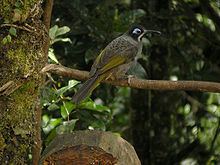Scientific name Melidectes Higher classification Honeyeater Order Passerine | Family Meliphagidae Phylum Chordata Rank Genus | |
 | ||
Lower classifications Belford's melidectes, Ornate melidectes, Vogelkop melidectes, Yellow‑browed melidectes, Sooty melidectes | ||
Belford melidect belford s melidectes mcu calls from one bird with others in the b g a few call
Melidectes is a genus of bird in the honeyeater family Meliphagidae. Nine of its ten species are endemic to New Guinea; the tenth species, Gilliard's melidectes, is endemic to nearby New Britain. Gilliard's melidectes is sometimes considered to constitute its own genus, Vosea, or has been placed with the sooty melidectes, the long-bearded melidectes and the short-bearded melidectes in the genus Melionyx due to similarities in size, plumage and the smaller bare patch around the eye. The generic name is derived from the Greek meli for honey and dektes for beggar or receiver.
Contents
- Belford melidect belford s melidectes mcu calls from one bird with others in the b g a few call
- Rainforest mornin rainforest morning belford s melidectes melidectes belfordi several singing
- Description
- Habitat
- Feeding
- Status and conservation
- Species
- References
Rainforest mornin rainforest morning belford s melidectes melidectes belfordi several singing
Description
They are medium sized honeyeaters, varied in appearance but possessing a long and sometimes stout bill and bare patch around the eye which is quite large and brightly coloured in some species. Their plumage varies from mostly patterned grey in the sooty melidectes to a brightly contrasting white, black and fawn in the ornate melidectes.
Habitat
The genus is overwhelmingly restricted to montane environments. They occupy mountain forest, forest edge, alpine shrubland and shrubby thickets in grasslands. In some instances where two species occupy similar ranges, for example the Belford's melidectes and the yellow-browed melidectes in the Schrader Ranges, the two species exclude each other and occur at different attitudes.
Feeding
The diet of the melidectes is not known for all species, but for those that are known it consists of insects, nectar, pollen, fruit and berries. The short-bearded melidectes has also been recorded eating seeds. They feed in all levels of the forest, and in shrubs and thickets in more open environments. Some have been recorded feeding on the ground, either on ground plants or picking through the leaf-litter. They usually feed as singles, also foraging in pairs or small groups. Like many honeyeaters they may be aggressive towards other birds, including berrypeckers, painted berrypeckers, other honeyeaters and even other members of the genus. One study found that the Belford's melidectes aggressively defended the flowers of the terrestrial root parasite Mitrastemmaa from the ornate melidectes.
Status and conservation
One species, the long-bearded melidectes, is considered to be threatened with extinction due to habitat loss, and it is therefore listed as vulnerable by the IUCN. Gilliard's melidectes is considered to be near threatened due to forest clearance on New Britain. Many of the other species of melidectes are restricted range species, occupying small global ranges; in many cases single mountain ranges. The most widespread species, the ornate melidectes, has actually benefited from human activities. That species prefers forest edge, secondary growth and gardens, and has apparently increased in numbers.
Species
The genus contains the following species:
